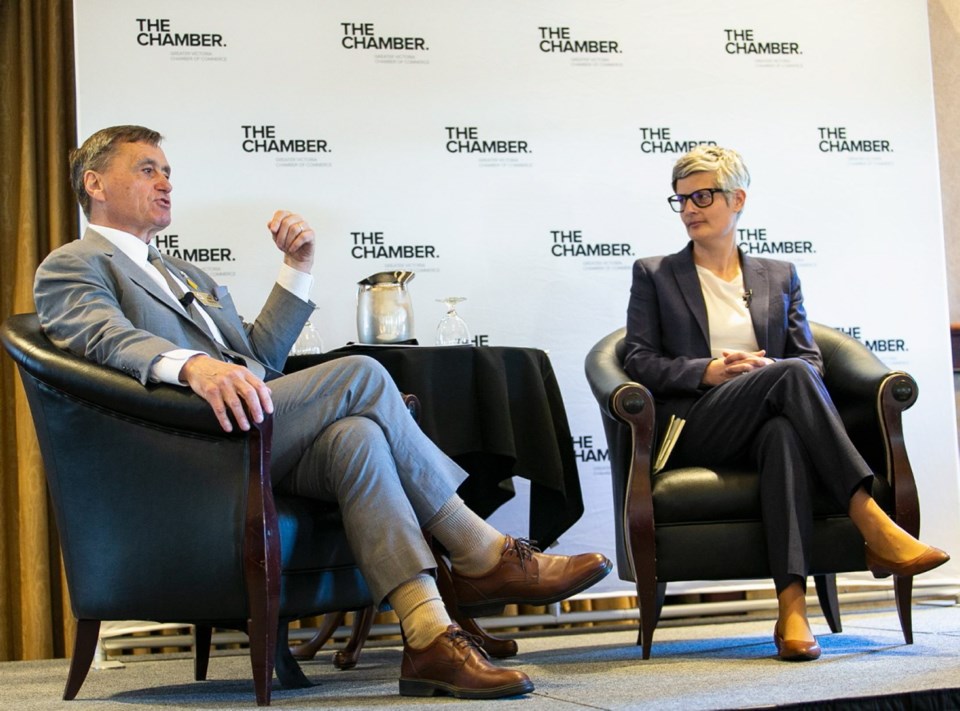Victoria Mayor Lisa Helps says she will gladly wave the flag for amalgamation if a citizens assembly determines it’s in the best interests of Victoria and Saanich.
Speaking to a sold-out Greater Victoria Chamber of Commerce luncheon on Tuesday, Helps was clear on what she would do when the assembly reaches its conclusions on the costs, benefits and disadvantages of amalgamation.
“I commit to being bound by whatever the citizens assembly determines is the best way forward. If [it] determines amalgamation is the best way forward, then I will become a champion of amalgamation when a referendum is held,” she said.
Should the assembly suggest harmonization of services between the two municipalities instead, Helps said she would back that, too.
“If we are going to undertake [the process] in good faith, we have to let it do what it needs to do, but we also must honour the results,” Helps said — although she added that Victoria council would not be bound by the citizens assembly conclusions.
Victoria and Saanich, the region’s two largest municipalities by population, are still in the process of establishing the assembly to explore the question of amalgamation.
The two mayors laid out the process for the business community Tuesday, and weren’t shy at taking light-hearted, if pointed, shots at each other’s city.
While Helps noted Saanich’s mailing addresses listed on the municipal website are in Victoria, Saanich Mayor Fred Haynes suggested it’s Saanich that puts the great in Greater Victoria.
Haynes set the tone for the hour-long session by warning that no one should pre-judge the outcome of a citizens assembly.
“Maybe we save costs from amalgamation, but maybe we save costs from not amalgamating — that’s the point of the citizens assembly,” he said.
He was also clear that he and his council see the process as non-binding.
“It can make recommendations to amalgamate or not amalgamate. I was not comfortable binding council,” he said, noting they are still not clear on how it will operate and how the process will unfold.
While Victoria’s council has already approved terms of reference that will guide the assembly, Saanich still has to approve a draft of its terms.
There are some significant differences in the two documents, with Victoria pushing for an assembly of 49 people (28 from Saanich and 21 from Victoria) that would meet four to six times between this fall and March of next year.
Saanich’s draft terms push for an assembly of 100 people that would meet more often.
Once Saanich has approved its terms of reference, committees from the two municipalities will negotiate combined terms for the assembly.
Haynes said Saanich hopes to have completed its process by the end of this month, which prompted Helps to suggest the two could begin negotiating as early as mid-June.
If that’s the case, the assembly could start meeting this fall and reach a conclusion in 2020. If the determination is to go forward with amalgamation, Victoria and Saanich would approach the province to set terms for a referendum.
Haynes said it’s possible the question could be put to voters by the end of 2020 or early 2021.
While it sometimes seemed Haynes was pouring cold water on the idea of amalgamation on Tuesday, he insisted he was impartial. Helps, on the other hand, appeared to have some enthusiasm for a combined municipality, noting it could offer economic and political opportunity.
“I’m not for or against. I’m open to a very good process that will unearth information that will allow us to have a better, more cohesive governance of the region.”



